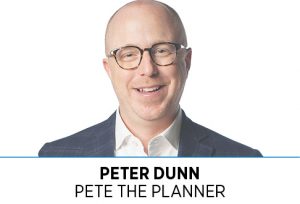Subscriber Benefit
As a subscriber you can listen to articles at work, in the car, or while you work out. Subscribe Now Dear Pete,
Dear Pete,
I’m a 28-year-old attorney, and the last few years in the stock market have my head spinning. Last year was bad, this year seems really good, and as I start to project my account balances at retirement, I’m unsure what rate of return to use. What do you use? I read a book when I was in law school written by a personal finance guru, and it suggested 12%. That seems high to me.
—Brandon, Indianapolis
It has been quite the roller-coaster ride in the market (S&P 500) over the last few years, hasn’t it? There was the capricious decline in late February and March of 2020 (34% decline Feb. 19 to March 23), then the ratcheting climb back up throughout 2021 (26.9% increase), and of course the most predictable (big) dip ever in 2022 (19.44% decline). And now, somehow, the S&P 500 is staring down a 20% year. All the while, the economy has been on the precipice of a recession. Fun times indeed.
Still to this day, plugging absurd average returns into financial-planning calculators tickles my soul. In fact, my column was almost late this week because I went down a 90-minute rabbit hole on my calculator. The different outcomes for different rates of return are shocking. But before I dazzle you with math, let’s see what the data says.
I happen to keep a spreadsheet listing the average returns of the S&P 500, bonds and a 60/40 mix of the two, going back to 1928. I update it every year. And, no, you can’t hire me to entertain your friends at parties. I keep running calculations of averages based on an all-time basis, 30-year basis, 25-year basis, 20-year basis, 15-year basis, 10-year basis and a five-year basis. I’m a good time.
The data is fascinating. For instance, do you think there was a higher average return over the last 10 years or the last 20 years? Over the last 20 years, the S&P 500 has averaged 9.43%, while over the last 10 years, it has averaged 11.89%. And just 10 years ago, the rolling 10-year average was 2.88%. Like I said, fun—for hours.
Let’s say you put $100,000 into an investment and left it alone for 30 years. If you used 9.43% as your average rate of return, you’d end up with $1.49 million. However, if you employed recency bias and illustrated 11.89%, you’d end up with $2.91 million.
Do you see the problem? Guessing the wrong percentage by as little as 2% can make a monumental difference. This is especially true if you plan around your assumptions. Using 12% as your average return for making retirement projections is an awful idea. As either Maya Angelou or Zig Ziglar first said (the internet is a tangle of truth and misattribution), “Hope for the best; prepare for the worst.”
This is expressly why, when I’m making projections for my own financial future, I illustrate 8%.
Having assisted people with these calculations for decades, there’s always a clump of people who, because of their appetite for risk, want to see what 20% looks like. Well, it looks silly, if I’m being honest. That $100,000 you set away for 30 years swells to $23.74 million, and stupidity ensues.
Don’t forget about asset allocation, either, by the way. Unless you plan to invest only in equities, you will need to blend the other returns into these projections, especially as you age. For instance, a 60/40 equity/bond blend over the last 20 years has averaged 7.23%. Not too shabby, if you ask me.
All this talk of returns is a distraction from the most important aspect of meeting your retirement goals—how much you invest on a regular basis. While you can’t fully control your destiny by aggressively funding your retirement account, you can certainly do more to affect your outcome than stewing over returns.
The next time you talk to your financial adviser, ask her what rate of return she uses to project your future retirement account balances. If the rate is much over 9%, ask why. Unless the average return can be sustained for decades, what’s the point of illustrating big numbers?
Will the market end up 20% this year? Maybe, but frankly, I just want 8% each and every year.•
__________
Dunn is CEO of Your Money Line powered by Pete the Planner, an employee-benefit organization focused on solving employees’ financial challenges. Email your financial questions to [email protected].
Please enable JavaScript to view this content.
